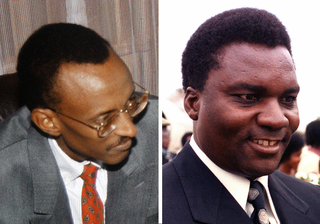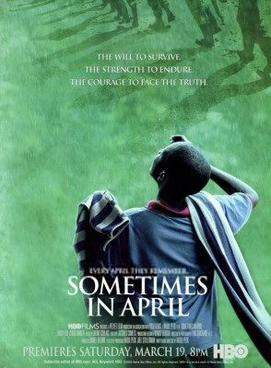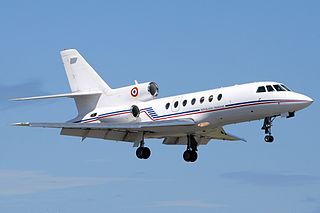Findings
Massacres
In the three major massacres that were investigated – which were themselves composed of a series of attacks over multiple days – the commission concluded that Rwandan authorities at all levels of administration held varying degrees of responsibilities. Most attacks were incited, encouraged, and led by civilian authorities, while Rwandan soldiers aided those that took place close to military bases. Given the timing, the presented pretext, and the habit of laying the blame on victims rather than perpetrators, the inquiry asserted that there was sufficient evidence of large, country-wide planning. By most accounts, the reactions of policing authorities were "slow, weak and unconcerned" and the judiciary had failed to prosecute alleged attackers. [3]
The massacre in Kibilira began on October 11, 1990, ten days after the beginning of the civil war, in a commune where Tutsi and Hutu had previously lived a relatively peaceful co-existence. At a meeting of communal councillors, the assistant prefect showed two dead bodies to the members present and claimed they were Hutu killed by Tutsi. He told the councillors to go home "sensitize the population" to the necessity of security measures. [3] Authorities then incited civilians to burn the homes of Tutsi, under the pretext that there was a larger plan to exterminate the Hutu. Some councillors spread false rumours about military authorities being murdered and a fabricated story of a Tutsi killing children at local schools.
Testimony given to the commission established a systematic targeting of the Tutsi population by local authorities who knew the villages, as Tutsi homes were ravaged but Hutu homes were untouched. As the attacks continued, targets shifted from Tutsi homes to Tutsi civilians themselves. One councillor incited killings by telling attackers "you’re doing nothing but killing and eating the cattle instead of showing me skulls." [3] From October 11 to October 13, 348 civilians were killed, 550 houses were burned, and nearly all animals and food had been pillaged. It took authorities 48 hours to respond.
The massacre of the Bagogwe [ fr ], a sub-group of Tutsi, was lesser known outside of the areas along the Gishwati forest where they lived. Within their prefectures, movement was limited by roadblocks, which prevent victims from fleeing and journalists and investigators from entering. Due to the area's isolation, authorities, including the president, were able to aptly deny the killings that took the lives of up to 1000 Tutsi. [3] The attacks were a result of the surprising domination by the RPF in the city of Ruhengeri, who then freed all prisoners from the city's jails. The Bagogwe, along with other Tutsi, were blamed for having helped the RPF and the massacre ensued. From January to March 1991, civilians were killed with stones, spears, sticks, and guns and the burial of bodies was often done under the pretext of mandatory community labour. From speaking with a former Rwandan secret agent, the commission heard that high authorities planned the massacre in January, before the RPF had gained control of Ruhengeri. President Habyarimana was present at the meeting and "acquiesced" to the proposed massacres "with a nod." [3]
Having heard that bodies were frequently dumped in caves, the commission searched for mass graves while investigating the massacre. Speleologists found evidence of possible sites of burial but due to limited materials and the unwillingness of witnesses to disclose exact locations, few were found. Exceptionally, a burial site was found in the backyard of a local official who claimed no prior knowledge of its existence, while another was found beside a field. [3]
The massacres in the region [ fr ] of Bugesera took place from March 5th to March 9th 1992, during which 277 people were killed and 15,000 were forced to flee their homes. Rwandan media, particularly Radio Rwanda, played an important role in spreading anti-Tutsi propaganda in the months leading up to the attacks culminating on March 3 when the station repeatedly warned of Tutsi plans to assassinate Hutu leaders. [3] Police and soldiers were dispatched from Kigali upon news of the attacks, however, the massacre continued for four days. Witness testimonies led commissioners to conclude that assailants included soldiers in civilian clothing. On March 9, authorities ordered thousands of displaced people to return home. Having nothing to return to and not wanting to risk their lives, the displaced were unwilling to move. In response, authorities ordered their water supply cut off. [3]
The report summarized the massacres as follows:
"…the massacres since October 1990 were neither accidental nor spontaneous, but the result of deliberate decisions taken at the highest levels. In the high structured Rwandan society, the authorities easily exercised power. Preparation for the massacres can sometimes be traced to long before the actual event…In executing the massacres, the key actors have ranged from local prefect authorities to members of the cell committee. In the cases of the Bagogwe massacre and the massacre in Bugesera, the military cooperated with the authorities in inciting people to attack their neighbours and in helping to carry out the killings." [3]
The Question of Genocide
On April 15, 1975, Rwanda signed the Genocide Convention thus forbidding genocide, along with any threats, incitements or complacency to commit genocide. Based on the testimony given to the commission, the majority of victims were killed based on their Tutsi ethnicity, demonstrating intent to murder members of an ethnic group. It was stated, however, that the casualty figures, while tragic, "may be below the threshold required to establish genocide." [3] The commission also noted complications due to the increasing number of targets who were Hutu political opponents to the Rwandan government.
Human Rights Abuses by the Rwandan Government
The commission documents abuses by the Forces Armée Rwandaise (FAR), which included both the national police and the military. Civilians were arrested for allegedly sympathizing with or aiding the RPF and would be severely beaten, killed, or disappear. Testimonies reported large summary executions, rape, forced labour, and looting. After pressure from the international community, the Rwandan government created a commission to investigate these abuses, which condemned the failure of authorities to prevent or stop the killings but stopped short of holding individuals accountable. [3] In at least two cases, the FAR faked military attacks on the RPF to provide justification for mass arrests, including the arrest of up to 10,000 people in October 1990, some of whom were summarily executed. The inquiry heard evidence of violations of international law, including the FAR killing RPF soldiers who had surrendered and the judicial failure to investigate military attacks on civilians. In the conclusion of the final report, it writes "President Habyarimana and his immediate entourage bear heavy responsibility for these massacres and other abuses." [3]
Human Rights Abuses by the Rwanda Patriotic Front
The commission primarily investigated the actions of the Rwandan government and the FAR, however from gathered testimony, the report acknowledges abuses by the RPF. The commission highlighted attacks on civilian targets, including a camp for displaced persons and a clinic, along with apparently random killings in villages. Summary executions, looting and destruction of property went seemingly unpunished. There were reports of conscription in the displaced camps, along with theft of animals and food supplies. The RPF was responsible for forced expulsion of populations, using some as porters and cattle herders to carry goods and justifying other movements as part of a strategy to empty combat zones from possible human casualties. Commissioners met with Rwandans in occupied RPF zones, from where they were able to choose individuals to give testimony. They were, however, unable to meet with the individuals privately. None of the witnesses complained of abuses but rather spoke of a desire to return home. Civilians were able to move between RPF sectors only after permission was granted and identity papers were submitted and all civilians were required to cultivate four days a week to benefit the larger community. [3]
Response and Criticism
Rwanda
Upon the release of the official report, Habyarimana and his government denoted the report as a biased document that had been influenced by opposition political parties who he believed were working through Rwandan human rights organizations. [7] In the weeks following, the Rwandan government launched a publicity campaign to highlight the specific abuses by the RPF. In response, the rebel group extended an invitation to the commission to return to the country to further investigate the allegations of the Rwandan government. A second visit was being considered before violence escalated in April 1994. [4]
Despite an initial unwillingness to admit of wrongdoings in his country, Habyarimana later released a joint statement with his prime minister acknowledging that human rights violations had occurred. The statement recognized the three massacres that the inquiry investigated and laid their responsibility with undisciplined military officers. The statement did not claim any systematic or governmental responsibility. The Rwandan government committed itself to several of the recommendations that had been put forth in the commission's final report, including a commitment to ensure the upholding of human rights in Rwanda regardless of ethnicity or political affiliation, promotion of national reconciliation, and a guarantee to carry out all aspects of the Arusha Accords. [7]
On April 6, 1994, Habyarimana, along with the Burundian president, were killed when their airplane was shot with a missile near Kigali; both the RPF and Hutu extremists were blamed for the attack. The assault intensified ethnic violence and acted as an impetus for the Rwandan genocide, which claimed the lives of up to 800,000 Rwandans.
Internationally
In Europe, the initial 200,000 printed copies of the report were fully distributed within a week. Two hours after its release, Belgium recalled its ambassador to Rwanda for consultations and, within two weeks, requested the recommendations of the commission's co-chair concerning the Belgium's policy towards Rwanda. France, which had been militarily involved in Rwanda, began to withdraw its troops from Rwandan soil in response to a ceasefire agreement, two days after the report was released. [4] The European Parliament passed a resolution condemning the abuses mentioned in the report and called on both the Rwandan government and the RPF to end the violations. [7] Reacting to the report, the United States government also condemned the offences and altered a $19.6 million aid package that was to be delivered to Rwanda, increasing the capital designated for humanitarian aid while decreasing the funding for economic development assistance. American funding to train six Rwandan military officers remained untouched. [7]
In preparing for an official visit on behalf of the United Nations Human Rights Commission (UNHRC), the report was used by Special Rapporteur Bacre Waly Ndiaye because of "its methodical and specific nature and the diversity and consistency of the testimony it contains." [6] In the final report, presented to the UNHRC, Ndiaye concluded that "the substance of the allegations contained in the Commission’s report could, by and large, be regarded as established." [6]
Human occupation of Rwanda is thought to have begun shortly after the last ice age. By the 11th century, the inhabitants had organized into a number of kingdoms. In the 19th century, Mwami (king) Rwabugiri of the Kingdom of Rwanda conducted a decades-long process of military conquest and administrative consolidation that resulted in the kingdom coming to control most of what is now Rwanda. The colonial powers, Germany and Belgium, allied with the Rwandan court.

Juvénal Habyarimana was a Rwandan politician and military officer who served as the second president of Rwanda, from 1973 until 1994. He was nicknamed Kinani, a Kinyarwanda word meaning "invincible".

Paul Kagame is a Rwandan politician and former military officer who is the fourth and current president of Rwanda since 2000. He previously served as a commander of the Rwandan Patriotic Front (RPF), a rebel armed force which invaded Rwanda in 1990. The RPF was one of the parties of the conflict during the Rwandan Civil War and the armed force which ended the Rwandan genocide. He was considered Rwanda's de facto leader when he served as Vice President and Minister of Defence under President Pasteur Bizimungu from 1994 to 2000 after which the "Vice President" post was abolished.

The United Nations Assistance Mission for Rwanda (UNAMIR) was established by United Nations Security Council Resolution 872 on 5 October 1993. It was intended to assist in the implementation of the Arusha Accords, signed on 4 August 1993, which was meant to end the Rwandan Civil War. The mission lasted from October 1993 to March 1996. Its activities were meant to aid the peace process between the Hutu-dominated Rwandese government and the Tutsi-dominated rebel Rwandan Patriotic Front (RPF). The UNAMIR has received much attention for its role in failing, due to the limitations of its rules of engagement, to prevent the Rwandan genocide and outbreak of fighting. Its mandate extended past the RPF overthrow of the government and into the Great Lakes refugee crisis. The mission is thus regarded as a major failure.

The Interahamwe is a Hutu paramilitary organization active in the Democratic Republic of the Congo and Uganda. The Interahamwe was formed around 1990 as the youth wing of the National Republican Movement for Democracy and Development, the then-ruling party of Rwanda, and enjoyed the backing of the Hutu Power government. The Interahamwe, led by Robert Kajuga, were the main perpetrators of the Rwandan genocide, during which an estimated 500,000 to 1,000,000 Tutsi, Twa, and moderate Hutus were killed from April to July 1994, and the term "Interahamwe" was widened to mean any civilian bands killing Tutsi.

The Rwandan genocide occurred between 7 April and 15 July 1994 during the Rwandan Civil War. During this period of around 100 days, members of the Tutsi minority ethnic group, as well as some moderate Hutu and Twa, were killed by armed Hutu militias. The most widely accepted scholarly estimates are around 500,000 to 662,000 Tutsi deaths.

The Burundian Civil War was a civil war in Burundi lasting from 1993 to 2005. The civil war was the result of longstanding ethnic divisions between the Hutu and the Tutsi ethnic groups. The conflict began following the first multi-party elections in the country since its independence from Belgium in 1962, and is seen as formally ending with the swearing-in of President Pierre Nkurunziza in August 2005. Children were widely used by both sides in the war. The estimated death toll stands at 300,000.

Opération Turquoise was a French-led military operation in Rwanda in 1994 under the mandate of the United Nations. The "multilateral" force consisted of 2,500 troops, 32 from Senegal and the rest French. The equipment included 100 APCs, 10 helicopters, a battery of 120 mm mortars, 4 Jaguar fighter bombers, 8 Mirage fighters, and reconnaissance aircraft. The helicopters laid a trail of food, water and medicine enabling refugees to escape into eastern Zaire. Opération Turquoise is controversial for at least two reasons: accusations that it was an attempt to prop up the genocidal Hutu regime, and that its mandate undermined the UNAMIR. By facilitating 2 million Rwandan refugees to travel to Kivu provinces in Zaire, Turquoise setup the causes of the First Congo War.

Radio Télévision Libre des Mille Collines (RTLM) was a Rwandan radio station which broadcast from July 8, 1993 to July 31, 1994. It played a significant role in inciting the Rwandan genocide that took place from April to July 1994, and has been described by some scholars as having been a de facto arm of the Hutu government.

The assassination of presidents Juvénal Habyarimana and Cyprien Ntaryamira in the evening of April 6, 1994 was the proximate trigger for the Rwandan genocide, which resulted in the murder of approximately 800,000 Tutsi and a smaller number of moderate Hutu. The first few days following the assassinations included a number of key events that shaped the subsequent course of the genocide. These included: the seizing of power by an interim government directed by the hard-line Akazu clique; the liquidation of opposition Hutu politicians; the implementation of plans to carry out a genocide throughout the country; and the murder of United Nations peacekeepers, contributing to the impulse of the international community to refrain from intervention.

The failure of the international community to effectively respond to the Rwandan genocide of 1994 has been the subject of significant criticism. During a period of around 100 days, between 7 April and 15 July, an estimated 500,000-1,100,000 Rwandans, mostly Tutsi and moderate Hutu, were murdered by Interahamwe militias.

The Rwandan Civil War was a large-scale civil war in Rwanda which was fought between the Rwandan Armed Forces, representing the country's government, and the rebel Rwandan Patriotic Front (RPF) from 1 October 1990 to 18 July 1994. The war arose from the long-running dispute between the Hutu and Tutsi groups within the Rwandan population. A 1959–1962 revolution had replaced the Tutsi monarchy with a Hutu-led republic, forcing more than 336,000 Tutsi to seek refuge in neighbouring countries. A group of these refugees in Uganda founded the RPF which, under the leadership of Fred Rwigyema and Paul Kagame, became a battle-ready army by the late 1980s.

Sometimes in April is a 2005 American made-for-television historical drama film about the 1994 Rwandan Genocide, written and directed by the Haitian filmmaker Raoul Peck. The ensemble cast includes Idris Elba, Oris Erhuero, Carole Karemera, and Debra Winger.
Simon Bikindi was a Rwandan singer-songwriter who was formerly very popular in Rwanda. His patriotic songs were playlist staples on the national radio station Radio Rwanda during the war from October 1990 to July 1994 before the Rwandan Patriotic Front took power. For actions during the Rwandan genocide, he was tried and convicted for incitement to genocide by the International Criminal Tribunal for Rwanda (ICTR) in 2008. He died of diabetes at a Beninese hospital in late 2018.

On the evening of 6 April 1994, the aircraft carrying Rwandan president Juvénal Habyarimana and Burundian president Cyprien Ntaryamira, both Hutu, was shot down with surface-to-air missiles as their jet prepared to land in Kigali, Rwanda. The assassination set in motion the Rwandan genocide, one of the bloodiest events of the late 20th century.
Seth Sendashonga was the Minister of the Interior in the government of national unity in Rwanda, following the military victory of the Rwandan Patriotic Front (RPF) after the 1994 genocide. One of the politically moderate Hutus in the National Unity Cabinet, he became increasingly disenchanted with the RPF and was eventually forced from office in 1995 after criticizing government policies. After surviving a 1996 assassination attempt while in exile in Kenya, he launched a new opposition movement, the Forces de Résistance pour la Démocratie (FRD). Sendashonga was killed by unidentified gunmen in May 1998. The Rwandan government is widely believed to be responsible for the assassination.
Gersony Report is the name given to the 1994 findings made by a team under Robert Gersony, which was under contract to the United Nations High Commissioner for Refugees and identified a pattern of massacres by the Rwandan Patriotic Front rebels during and after their military victory in the civil war in post-genocide Rwanda. The findings were suppressed by the United Nations and involved governments for political reasons, and its existence was denied. No final written report was ever completed, though purported early written documentation has been leaked. The validity of Gersony's purported findings continue to be disputed.

The role of France in the 1994 Genocide against the Tutsi has been a source of controversy and debate both within and beyond France and Rwanda. France actively supported the Hutu-led government of Juvénal Habyarimana against the Tutsi-dominated Rwandan Patriotic Front, which since 1990 had been engaged in a conflict intended to restore the rights of Rwandan Tutsis both within Rwanda and exiled in neighboring countries following over four decades of anti-Tutsi violence. France provided arms and military training to Habyarimana's militias, the Interahamwe and Impuzamugambi, which were among the government's primary means of operationalizing the genocide following the assassination of Juvénal Habyarimana and Cyprien Ntaryamira on April 6, 1994.
Jean-Baptiste Habyalimana was a Rwandan academic and politician who served as the Prefect of Butare and was killed during the Rwandan genocide in 1994. He was the only Tutsi prefect at the time of the genocide, and also the only prefect belonging to the Liberal Party. He had resisted the genocide.

In Praise of Blood: The Crimes of the Rwandan Patriotic Front is a 2018 non-fiction book by Canadian journalist Judi Rever and published by Random House of Canada; it has also been translated into Dutch and French. The book describes alleged war crimes by the Rwandan Patriotic Front (RPF), Rwanda's ruling political party, during its ascent to power in the 1990s.














